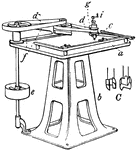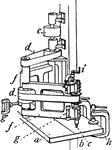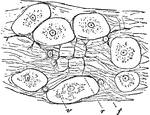
Connective Tissue
"Connective tissue of slug. r, ramified cell; f, flattened cell; v, vesicular cell. The fibers in the…
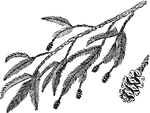
Redwood Branch
A Californian timber tree. Grows 200 to 300 feet high and have a thick cinnamon colored bark. The inside…
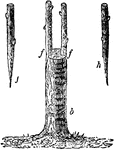
Crown-Grafting
"Crown-grafting is preferable to cleft-grafting, inasmuch as it leaves no open spaces in the wood. The…

Root-Grafting
"Fahlias and paeonies may be grafted by inserting young shoots into the neck of one of the fleshy roots…

Root-Grafting
"In the case of large woody plants thus worked the grafted roots, after the operation is completed,…

Shield-Budding
"The simplest and most generally practised form of budding is that called Shield budding or T-budding.…

Single Eye
"This mode of propagation is performed by cutting the branches into short lengths, each containing one…
Pruning
"The nature of the cut itself in pruning is of more consequence, especially in the case of fruit trees,…

Pruning
"The nature of the cut itself in pruning is of more consequence, especially in the case of fruit trees,…
Pruning
"The nature of the cut itself in pruning is of more consequence, especially in the case of fruit trees,…
Pruning
"The nature of the cut itself in pruning is of more consequence, especially in the case of fruit trees,…
Pruning
"The nature of the cut itself in pruning is of more consequence, especially in the case of fruit trees,…
Pruning
"The nature of the cut itself in pruning is of more consequence, especially in the case of fruit trees,…

Summer Pruning
"Summer Pruning should be performed while the shoots are yet young and succulent, so that they may be…
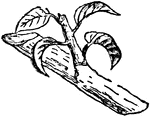
Summer Pruning
"Summer Pruning should be performed while the shoots are yet young and succulent, so that they may be…
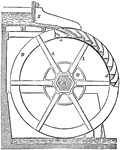
Water Wheel
"When a water fall ranges between 10 and 70 feet, and the water supply is from 3 to 25 cubic feet per…

Diblastula
"Diagram of a Diblastula. a, orifice of invagination (blastopore); b, archenteric cavity; c, endoderm;…

Diblastula
"Formation of the Diblastula of Eucope (one of the Calyptoblastic Hydromedusae) by delamination. A,…

Epiderm Cels
"Epidermo-muscular cells of Hydra m, muscular-fiber processes." — Encyclopedia Britannica, 1893
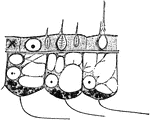
Body-wall
"Portion of the body-wall of Hydra, showing ectoderm cells above, separated by "structureless lamelia"…

Nematocyst
"Nematocyst of Hydra, showing cell-substance and nucleus, cyat, trigger hair, and everted thread." —…

Endoderm Cell
"Vacnolated endoderm cells of eartilaginous consistence from the axis of the tentacle of a Medusa (Cunina)."…
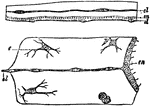
Medusae
"Portions of sections through the disc of medusae. The upper one of Lizzia, the lower of Aurelia. el,…
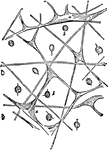
Aurelia
"Gelatinous substance of the disc of Aurelia, showing-a, fibrous trabeculae, and b, wandering endoderm…

Muscular Cells
"Muscular cells of medusae (Lizzia). The uppermost is a purely muscular cell from the sub-umbrella;…

Ocellus
"Ocellus of a medusa (Lizzia Koellikeri). oc, pigmented ectodermal cells; l, lens." — Encyclopedia…

Trachomedusae
"Simple tentaculocyst of one of the Trachomedusae (Rhopalonema velatum). The process carrying the otolith…
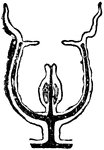
Sporosae
"Gradual degeneration of the medusa bud into the form of a sporosae. The black represents the enteric…

Sporosae
"Gradual degeneration of the medusa bud into the form of a sporosae. The black represents the enteric…
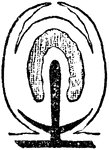
Sporosae
"Gradual degeneration of the medusa bud into the form of a sporosae. The black represents the enteric…
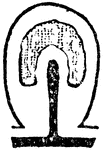
Sporosae
"Gradual degeneration of the medusa bud into the form of a sporosae. The black represents the enteric…
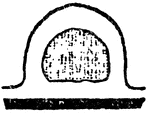
Sporosae
"Gradual degeneration of the medusa bud into the form of a sporosae. The black represents the enteric…

Sporosac
"Two female sporosacs (degenerate medusae) of Hydraetinia echinata. a, ectoderm; b, endoderm; o, eggcella;…

Fucus Vesiculosus
"Fucus vesiculosus: showing the receptacles of the fructification a, a, at the ends of the branching…
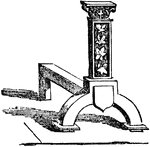
Andiron
"Andirons were used for burning wood on an open hearth, and consisted of a horizontal bar raised on…

Dalmatic
"The deacon's robe, in the Roman Catholic Church. the most ancient form of the dalmatic is exhibited…
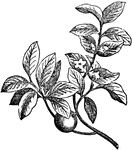
Ebony
"A wood remarkable for its hardness, heaviness, and deep black color, is the heart-wood of different…

Epithelium
"Portion of epithelium from the tentacle of an Actinian, showing three supporting cells and one sense…
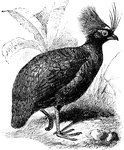
Crested Wood Partridge
The male and female are green in color and have sarlet colored skin around the eyes. Usually small and…

Scorpion Eyes
"Development of the lateral eyes of a scorpion. h, Epidermic cell-layer; mes, mesoblastic connective…
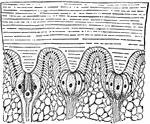
Limulus
"Section through a portion of the lateral eye of Limulus, showing three ommatidia—A, B and C.…
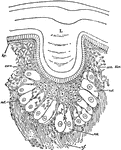
Limulus
"Section through one of the central eyes of a young Limulus. L, Cuticular or corneous lens. hy, Epidermic…

Spirillum
"Spirillum containing many spores (a), which are liberated at b by the breaking up of the parent cells."…
Basset Horn
"A wood-wind instrument, not a "horn," member of the clarinet family, of which it is the tenor. The…

Mortising
"Mortising is a method of insertion in which the projecting extremity of one timber is received into…

Mortising
"Mortising is a method of insertion in which the projecting extremity of one timber is received into…

Mortising
"Mortising is a method of insertion in which the projecting extremity of one timber is received into…
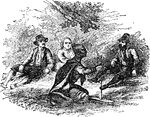
Native American Teachers
"Indian explaining the method of kindling a fire by the friction of two pieces of wood." —Wells,…
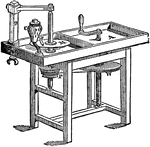
Lapidary's Mill
"In the ordinary pattern of a lapidary's bench the handle turns in a horizontal plane, where W is the…
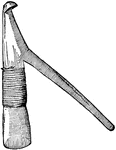
Jadeite Axe
An instrument used for hewing timber and chopping wood, and also used as a weapon of offense.
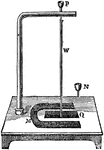
Wire Vibration
"Vibration of a wire. A conducting copper wire, w, is suspended by a loop from a hook of the same metal,…

Electrical Helix
"A copper wire coiled, by winding it around a piece of wood. The turns of the wire should be close together…


